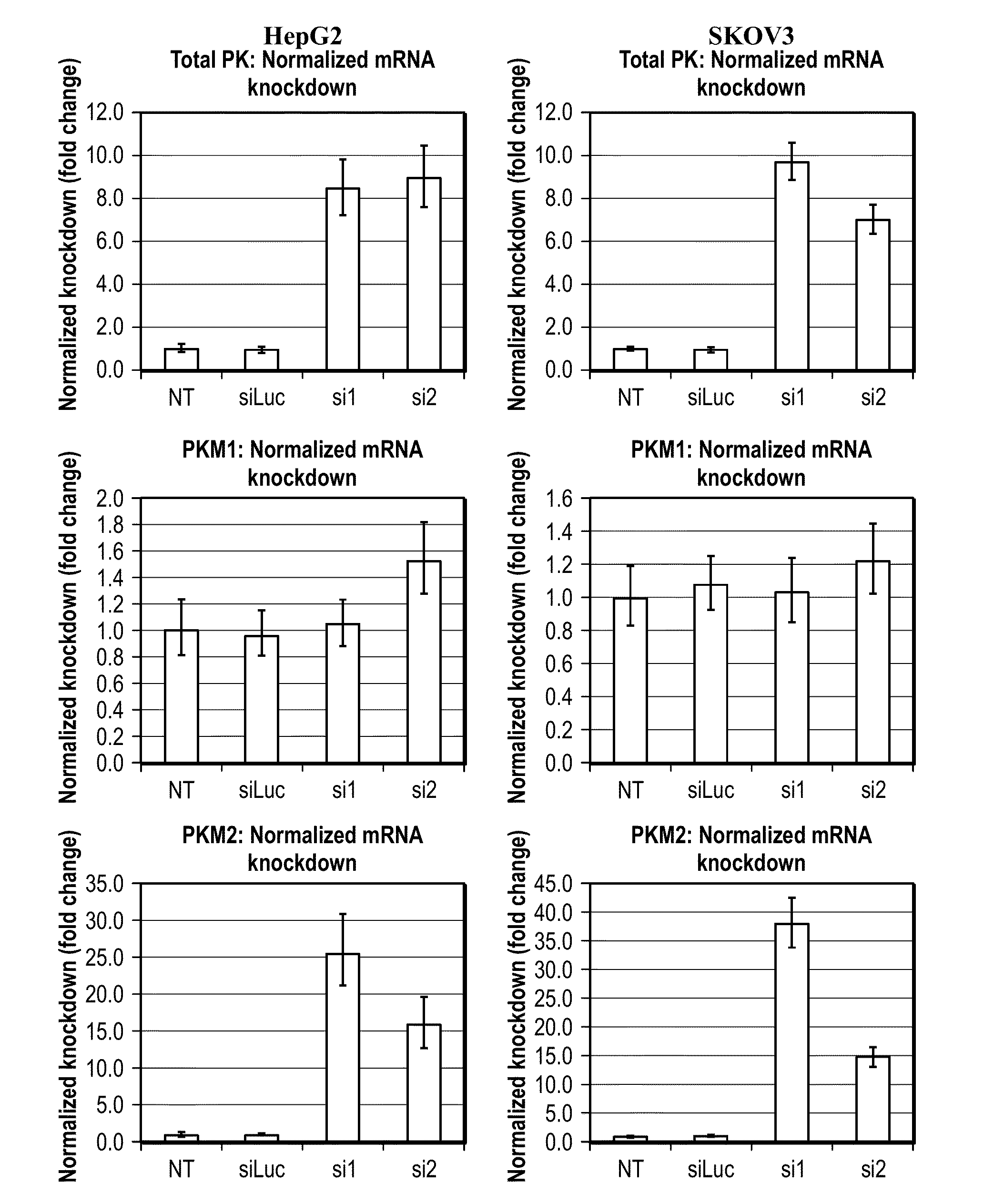Sirnas targeting exon 10 of pyruvate kinase m2
a pyruvate kinase and exon 10 technology, applied in the field of nucleic acid molecules, can solve the problems of decreasing cell viability and proliferation, and achieve the effect of decreasing the expression of pkm2
- Summary
- Abstract
- Description
- Claims
- Application Information
AI Technical Summary
Benefits of technology
Problems solved by technology
Method used
Image
Examples
example 1
Identification of siRNAs that Confer Specific Knockdown of PKM2
[0186]Using every siRNA design algorithm that is publicly available, we attempted to identify sequences that would target the M2 isoform of pyruvate kinase specifically. Not one algorithm yielded an siRNA that targeted a sequence in exon 9 (M1) or exon 10 (M2) when given the entire pyruvate kinase muscle transcript as an input sequence. Upon narrowing down the input to exon 10 (M2), most algorithms did not yield a single hit. Only two sequences, designated si1 and si2, were suggested by more than one algorithm.
[0187]Four cell lines (HepG2, SKOV3, A549, and KB), representing four different cancer types (liver, ovarian, lung, and nasopharyngeal, respectively) were transfected with these two siRNAs. Real-time PCR was used to confirm that the knockdown was robust and specific (FIG. 1). With minimal effect on PKM1 levels, si1 conferred as much as 38-fold knockdown. si2 was moderately less specific and potent but still promisi...
example 2
siPKM2 Reduces Cell Viability and Induces Apoptosis
[0190]To confirm that the knockdown had an effect on phenotype, we examined cell proliferation (FIG. 4a,b). si1 and si5 afforded the greatest effect across the two cell lines, while si3, si7, and si8 also induced a marked decrease in viability. Importantly, this decreased relative viability could be attributed to apoptosis rather than simply inhibition of proliferation (FIG. 4c-e).
example 3
si1 Leads to Profound Regression of Tumor Volume in Vivo
[0191]A member of the lipid-like class of materials dubbed “lipidoids”12 was used to encapsulate and deliver siRNA to the xenografts. The selected lipidoid, ND98, has previously been shown to knock down claudin-3 in vivo, resulting in reduction of tumor volume and extension of survival in two mouse models of ovarian cancer13. HepG2 and SKOV3 cells were implanted as subcutaneous xenografts in scid mice. When tumors became established (>100 mm3), mice were treated with either si1 or siControl every 2 days for 2 weeks. The trial was halted when the control group had to be euthanized. Treatment with si1 prevented tumor expansion and even resulted in dramatic volume reduction (FIG. 5). Indeed, nearly all of the measured volume in the treated mice could be attributed to scar tissue caused by the intratumoral injections. There was no remnant of HepG2 tumor in half of the si1-treated animals, and there was no remnant of SKOV3 tumor in ...
PUM
| Property | Measurement | Unit |
|---|---|---|
| Length | aaaaa | aaaaa |
| Composition | aaaaa | aaaaa |
| Structure | aaaaa | aaaaa |
Abstract
Description
Claims
Application Information
 Login to View More
Login to View More - R&D
- Intellectual Property
- Life Sciences
- Materials
- Tech Scout
- Unparalleled Data Quality
- Higher Quality Content
- 60% Fewer Hallucinations
Browse by: Latest US Patents, China's latest patents, Technical Efficacy Thesaurus, Application Domain, Technology Topic, Popular Technical Reports.
© 2025 PatSnap. All rights reserved.Legal|Privacy policy|Modern Slavery Act Transparency Statement|Sitemap|About US| Contact US: help@patsnap.com



